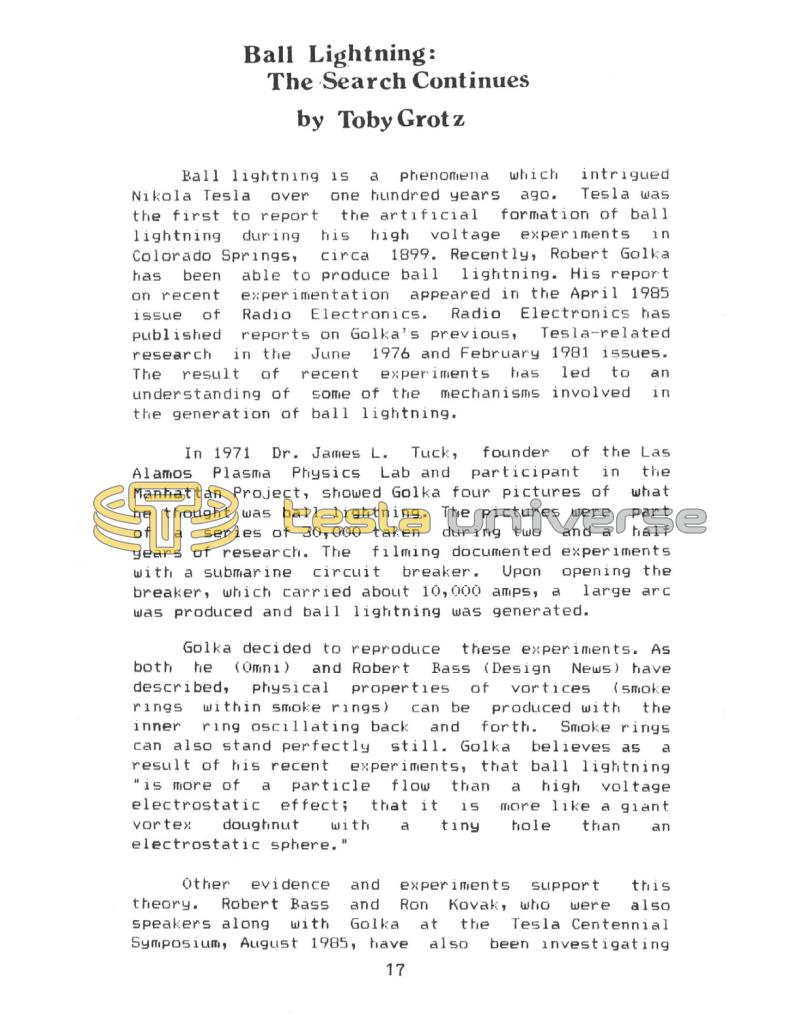
Nikola Tesla Articles
Ball Lightning: The Search Continues
Ball lightning is a phenomena which intrigued Nikola Tesla over one hundred years ago. Tesla was the first to report the artificial formation of ball lightning during his high voltage experiments in Colorado Springs, circa 1899. Recently, Robert Golka has been able to produce ball lightning. His report on recent experimentation appears in the April 1985 issue of Radio Electronics. Radio Electronics has published reports on Golka's previous, Tesla-related research in the June 1976 and February 1981 issues. The result of recent experiments has led to an understanding of some of the mechanisms involved in the generation of ball lightning.
In 1971 Dr. Jame L. Tuck, found of the Los Alamos Plasma Physics Lab and participant in the Manhattan Project, showed Golka four pictures of what he thought was ball lightning. The pictures were part of a series of 30,000 taken during two and a half years of research. The filming documented experiments with a submarine circuit breaker. Upon opening the breaker, which carried about 10,000 amps, a large arc was produced and ball lightning was generated.
Golka decided to reproduce these experiments. As both he (Omni) and Robert Bass (Design News) have described, physical properties of vortices (smoke rings within smoke rings) can be produced with the inner ring oscillating back and forth. Smoke rings can also stand perfectly still. Golka believes as a result of his recent experiments, that ball lightning "is more of a particle flow that a high voltage electrostatic effect; that it is more like a giant vortex doughnut with a tiny hole than an electrostatic sphere."
Other evidence and experiments support this theory. Robert Bass and Ron Kovak, who were also speakers along with Golka at the Tesla Centennial Symposium, August 1985, have also been investigating ball lightning. Bass and Golka have mathematically predicted the size of ball lightning. Kovak has photographed the effect using a large Tesla coil. The size of the fireball measured from enlargements of his photograph have confirmed the predicted model. Kovak is presently in the process of duplicating the effect with a full compliment of instrumentation designed to observe the spectral emissions in both the visible and radio frequency portions of the electromagnetic spectrum.
Kovak suggests that the locical extension of Golka's experiments would be to use a low velocity wind tunnel with controlled arc discharges to form ball lightning. By demonstrating the phenomenon over and over again, we will be able to gain a working understanding of the nature of ball lightning. This understanding of ball lightning may lear to the solution of confinement of plasma, a necessary requirement for a controlled fusion reaction.
Golka's initial search for equipment suitable to reproduce the Tuck experiment ended with a submarine missing its propellers and having only one working engine. An ingenious alternative was found in the donation of a diesel locomotive and one and one-half miles of track by the president of the Boston and Maine Railroad.
Using a submarine circuit breaker connected between the million watt, 1600 horsepower diesel generators and the 2000 horsepower motors, Golka was able to generate ball lightning by interrupting the circuit. A broom handle was used to open the breakers. A large arc would be produced, and the temperature inside the cab of the locomotive would rise from 60 F to 110 F almost immediately.
This traveling experiment in plasma physics produced the expected results when Golka realized that turbulence might be a factor in the production of ball lightning. Initially, the circuit breaker had been mounted over the updraft issuing from the engine radiators. By shielding the breaker from air currents and by closing the doors and windows of the cab, ball lightning was repeatedly produced and filmed. Three color photos, which show the effect of ball lightning drifting off to one side, have been reproduces in the April 1985 issue of Radio Electronics.
In the theory of fluid dynamics, of which aerodynamics is a part of, little is known about the nature of fireballs. Many remaining questions about the ball lightning need to be answered before the investigation, started almost a century ago by Nikola Tesla, can be ended.
